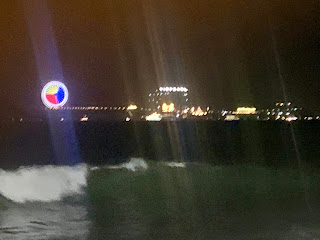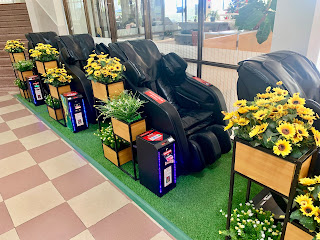24th - 25th Dec 2022
Friday, 30 December 2022
Tuesday, 27 December 2022
ON TO NHA TRANG
19th - 23rd Dec 2022
 Leaving Dalat I was again impressed by the mile upon mile of plastic covered flower nurseries (left). In some places as far as the eye could see.
Leaving Dalat I was again impressed by the mile upon mile of plastic covered flower nurseries (left). In some places as far as the eye could see. We stopped somewhere at the bottom of the mountains for a coffee/pee break. Vietnam is a major coffee producer but I still haven't got to enjoy the Vietnamese style of coffee which is served, either hot or iced, in thimble sized cups, and it is very bitter and strong taken 'black'. They often like it very sweet with condensed milk. While here a local (I assumed) generously gave me what he called a 'bamboo rice' to eat; a local delicacy he told me. It was a 12" long tube of bamboo with sticky rice packed inside which you had to squeeze out with a plunger. He was watching me in anticipation of my ecstasy. I politely ate as much as I could....it was not delicious.
We arrived in Dalat at the well out of town bus depot at 2.30pm and, studiously avoiding the persistent and pestilential rip-off taxi drivers, was shown to a 'complimentary' minibus which delivered me, free of charge, to my hotel.
I'm not sure if it is 'out of season' here, but there seemed surprisingly few tourists around the place. On the two mornings I had breakfast in the very large dining room which served a splendid selection of food, there were only three other guests (and it didn't look to me as if there had been any others in previously). The last time I was here (admittedly 10 years ago) at this time of year the city was thronged with tourists. Someone told me that the Chinese had made up about 60% and Russians 20% of tourists in the past. Well, Messrs Xi and Putin have put an inglorious stop to that malarky!
The city is packed with hotels; indeed they are wall to wall down the seafront including some vast swanky 35 storey jobs. The website I visited to book listed 556 hotels of varying size. And that was only one website of many. I began to think that you could put all the present tourists into one of the 35 storey hotels and they would still have rooms spare.
The beach here runs in a crescent, north to south, for about 4 miles. The main 'touristy' area with the most bars/restaurants is about ⅔ down towards the southern end. As such, after two nights I decided to move to a hotel in this area. Again, there was an infinite choice and I ended up in an equally lavish establishment, the DTX Hotel, for £15 pn.
There were a couple of decent watering-holes which I frequented; The Sailing Club restaurant (poor photo right) and a pleasant open-air beachside bar called Blue Seas.
The last time I was here, in 2012, I visited an island, Hôn Tré, about a mile off-shore which contained a small version of Disneyworld with 'faux' fairytale castles, casinos, funfairs and stage performances etc. It is called Vinpearland. It was rather fun, relatively cheap and you got over to it by a cable car from south of the southern end of the beach. I decided to pay another visit.
Walking along the beach area one encountered several old ladies carrying, slung over their shoulders, large boards (6ft x 8ft) displaying sunglasses of differing styles. I counted about 80 specs on each board. I never saw them sell one. More in hope than expectation I think.
All along the seafront between the beach road and the beach is a grassy area with many exercise contraptions. The locals seem to enjoy using them (right). I joined in with one; the hand-wheel thing. For the life of me I couldn't work out what good it was likely to do me. This chap was obviously very 'health conscious' by wearing a face-mask. A 'TIM'.
Left: Another rather pointless 'exercise' machine. They might just as well go for a good walk. Having said that you don't see any fat Vietnamese. Diet? Exercise? Genetics? They set a good example unlike the many flabby obese monsters that wobble around the streets in UK.
 I spent three full days here and did or saw nothing out of the ordinary, but it was a relaxing time, the weather was warm and I happily idled about in some comfort. For the more adventurous there are many islands off-shore which offer, apparently, great scuba diving in crystal clear water. I'm not into that. It was a pity about Vinpearland!
I spent three full days here and did or saw nothing out of the ordinary, but it was a relaxing time, the weather was warm and I happily idled about in some comfort. For the more adventurous there are many islands off-shore which offer, apparently, great scuba diving in crystal clear water. I'm not into that. It was a pity about Vinpearland!Friday, 23 December 2022
ĐÀ LẠT. DAY TOUR PART 2
17th - 18th Dec 2022
 |
| Yo Ho Ho! Merry Christmas? |
So on with the tour. After lunch we set off to the north of the city and parked outside a large covered football pitch sized area growing cherry tomatoes and strawberries. This, apparently, was called the Japanese Market. We were handed plastic baskets and encouraged to forage. I got rather carried away and filled my basket up with strawberries. What I hadn't realised beforehand was that our baskets were to be taken and weighed and we had to pay for what we had collected! I had seriously overdone it and it was rather an expensive exercise. We boxed our pickings and I had far more strawberries than I could possibly eat. I later gave them to the nice girl at my hotel reception.
I made several observations. Firstly, they were in no way 'puppies'. Secondly, they were certainly a 'variety' of breeds ie. mongrels. Thirdly, there were some very fat and bad-tempered Corgi-type creatures amongst them which I witnessed on one occasion snapping at a frightened child.
I don't know how they were kennelled or looked after. There were some spartan looking cages in the background, but at least they appeared well fed. Possibly with cherry tomatoes and strawberries from the Japanese Market nearby?
Right: The next, and final, stop was at a church somewhere in town. I believe this was one of the 'stand-by' venues. It was called 'Domaine de Marie' and Richard explained the history which involved a wealthy French lady, sometime back in the 19th century, sponsoring it to be built. There was more to it, but I didn't take notes!
Left: A well constructed 'nativity' diorama outside.
Right: Inside the church. Much like any other I suppose, and well kept.
Left: Another 'crib' display inside. They are obviously keen on these.
Right: Richard, our charming, and patient, guide.
The next day, after walking to the main bus station to check on further travel timings and short of anything else to do, I decided to walk on up to and take a ride on the cable car, the terminus of which is close by. This travels over some hilly forested countryside to the Truc Lam monastery, a distance of about 2.5 kilometres. The 'cars' each seat 4 people. I shared mine on the way out with an amusing Serbian tourist. I wandered around the monastery (done previously with photos in Jan 2020), had a spot of lunch, and came back...solo in my own 'car' this time. It was very windy. I don't have a great head for heights in these contraptions and with it swinging around in the wind one's imagination begins wonder what might happen if anything snaps! I was concentrating too much on possible landing sites below.
I think that will do from Dalat. I am next off, by bus again, to the seaside city of Nha Trang...a 3.5 hour journey down the mountains to the north-east.





















































